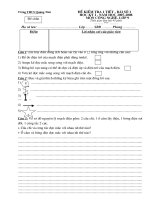bài luyện nghe số 1 chuyên ngành CNSH
Bạn đang xem bản rút gọn của tài liệu. Xem và tải ngay bản đầy đủ của tài liệu tại đây (58.94 KB, 2 trang )
All About the Birds and the Bees No, Just the Bees
By Mario Ritter
Broadcast: Tuesday, December 20, 2005
I'm Steve Ember with the VOA Special English Agriculture Report.
Most people have heard the sound of bees among flowers. Bees live almost everywhere in the world
except the arctic areas. Many kinds of agriculture depend on these small, social insects. Without bees, fruit
and nut growers as well as many other farmers would not have a crop.
There are more than twenty thousand kinds of bees. But only honey bees make enough honey for people to
use. Honey bees are highly organized social insects. They work together in a group called a colony. Each
colony lives in a hive. It contains one queen bee she lays all the eggs from which the members of the
colony come. Each colony has only a few hundred males, called drones. The majority of all bees in a colony
are workers, which are all females.
Bees even have a special stomach, called a honey stomach. It is used to store sweet fluid that the bees
gather from flowers. Bees also have long hairs on their body and legs. These hairs capture pollen as bees
go from flower to flower. Some of the pollen is taken back to the hive. Some, however, is passed to the next
flower. This is how many plants are fertilized. Pollen is the reproductive material of plants. Many important
agricultural crops depend on bees for fertilization.
Inside their hives, bees store sweet fluid from flowers, called nectar, and also pollen. They may even gather
nectar from some other kinds of insects. These kinds of nectar are also stored in the hive. Bees have organs
that produce a fatty substance called wax. They use wax to build structures in the hive that hold eggs and
store honey.
Bees make honey through a process. They add liquid from their own mouths to the nectar they have stored
in the hive. The liquid breaks down the nectar into simple sugars. As the honey is stored, it dries. It becomes
thicker and darker.
Honey can be very thin and light in color or dark and thick. How the honey looks depends on the kinds of
flowers used by the bees. Most honey is the easily recognized golden color. Although bees are often thought
of as honey-makers, they provide a surprising number of products. Also, their greatest economic value is in
fertilizing crops not in making honey.
Next week, we will tell about important products provided by bees. We will also tell about problems in
beekeeping.









